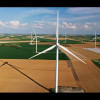Exploiting Newton’s law of gravity to store green energy

Many power plants these days harness energies from solar radiation, wind, ocean waves, and other green sources. However, like many other innovations, these sources have downsides. We can generate abundant green power only when the sun shines or the wind blows or the waves roll.
What do we do when the skies become dark and winds and oceans are calm? How do we satisfy the requirements of our energy-ravenous society?
The solution to this predicament is based on the immutable Newtonian logic: "What goes up, must come down." It is the gravity battery that replicates the fabled story of Isaac Newton's falling apple, but reconfigured on a much larger scale – with a little twist.
When a colossal mass, such as a concrete block, is lifted to a greater height using surplus green energy, it is stored in the block as gravitational energy. Also known as potential energy, it is the energy stored in an object because of its elevated position relative to the ground. The greater the height is, the greater potential energy is. When the block is lowered, potential energy is converted into kinetic energy, which sets the turbine of a generator into motion, producing electricity.

Energy generated from gravity batteries is sustainable. Furthermore, they will store green energy when there is too much and release it into the grid when there is too little. Besides, the tremendous weight of the block coupled with its slow descent will create a huge amount of rotational force – or torque – in the generator, allowing it to deliver maximum power almost instantaneously.
Gravity batteries have some distinct advantages over other batteries, such as lithium-ion or nickel-cadmium batteries that lose their capacity to store energy in a few years. Consequently, they have a short lifetime, and recycling these batteries is difficult. Moreover, whereas mining the minerals – cobalt, lithium, manganese, nickel, cadmium and other rare earth elements – required for these batteries poses environmental problems and health-related risks for the miners, a block of iron needed for a gravity battery has a much lighter environmental footprint.
Because gravity batteries are mechanical devices, they can break. For example, a cable can snap, or a winch can jam, or a patch of rust can appear in a metallic part. Though problematic, these issues are not beyond repair, because individual components can be fixed or replaced with relative ease instead of replacing the entire system. So there is real scope for a gravity battery to have an operational life spanning a few decades.
Gravitricity Ltd, a UK-based green engineering company founded in 2011, is working to make gravity batteries a reality. The company successfully tested its first prototype: an iron block weighing 50 tonnes, hoisted 15 metres up before gradually releasing it back, powering a series of electric generators with the downward gravitational force.
When fully operational, Gravitricity expects each battery to release between one megawatt (MW) and 20MW at peak power for up to eight hours. According to their website, a 20MW power system "could power 63,000 homes for every hour that it discharges."
Gravity batteries can also be deployed underground, leaving a significantly smaller surface footprint. They can be installed in abandoned mine shafts deep enough to house a full-sized battery. Electricity can be generated by raising the weights in the shaft, and then lowering them to activate a generator. Some researchers even came up with an unconventional yet ingenious idea of turning skyscrapers essentially into huge gravity batteries.
Gravitricity is exploring the possibility of having a battery consisting of 24 weights, each weighing 500 tonnes, for a total of 12,000 tonnes located down a shaft at a depth of at least 300 metres. Once operational, the battery with a 50-year design life is anticipated to generate 20MW of power with a maximum efficiency of 80 percent.
The idea of restoring abandoned sites of fossil fuel as repositories for green energy is not only eminently practical, it also embodies the values of "just transition," which preaches principles and practices for transforming extractive economy into a regenerative one.
Established in 2017 in southern Switzerland, Energy Vault is another leader in developing gravity batteries. When green power supply exceeds demand, the excess energy is used to lift a pair of 30-tonne blocks upwards to the top of a steel and concrete structure standing more than 20-storeys tall. When demand exceeds supply, they are dropped down, generating enough electricity for thousands of homes.
Gravity batteries can also work on a small scale for use in places such as a remote village or a shed. It works on a simple principle. Attach to the light bulb hanging from a wall or ceiling a bag filled with rocks, sand, or any heavy object, and then winch it up to the top. As the bag gradually drops to the ground, it will drive a generator through a gearbox converting the motion to electricity that will light up the bulb for about 20 minutes, without using any fossil fuel.
Another gravity-based energy storage technique is called Pumped Storage Hydropower (PSH). It uses the force of gravity to produce electricity by funnelling water uphill using surplus solar, wind or other green power, and then, when needed, forces it down to drive the electricity-generating turbine in a power station. Unlike conventional hydropower plants, PSH recycles the water. First used in the US in 1930, PSHs have a long life with minimal maintenance requirement and little ecological repercussions. PSH facilities can be found in many countries now.
The world needs bold and innovative climate solutions right now, particularly for storing green energy for later use. On this front, there may not be any silver bullets. But gravity batteries – with their harnessing of a truly infinite, omnipresent gravitational force – certainly have a role to play. The big question is: how soon will gravity batteries come to fruition?
Dr Quamrul Haider is a professor of physics at Fordham University in New York, US.

 For all latest news, follow The Daily Star's Google News channel.
For all latest news, follow The Daily Star's Google News channel. 









Comments